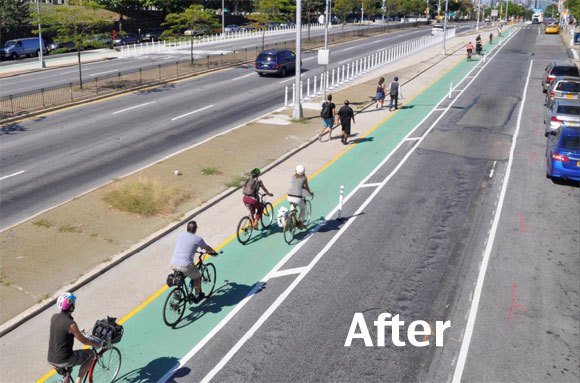We received more than a dozen submissions from all over the country for this year's Best Street Transformation competition -- thank you to everyone who nominated a redesign!
Streetsblog staff has narrowed the field down to six finalists. The top street transformations come to us from San Francisco, Oakland, Chicago, Atlanta, Pittsburgh, and Rochester.
Take a look at these fine street redesigns and then vote for your favorite. The voting is open until Tuesday at midnight Eastern time.
Enjoy the holiday -- we'll be posting Streetsies after Christmas and back to publishing on our normal schedule after the New Year.
Oakland: Telegraph Avenue
These curbside, parking-protected bike lanes went in this spring in Oakland's KONO District, and the plan is to extend the treatment from there.
The new design also narrowed general traffic from two lanes in each direction to one lane, while adding center turn pockets. Some car parking spots have been replaced with on-street bike corrals. Streetsblog California Editor Melanie Curry reports that the redesign is a huge improvement for cycling, and the city is committed to it despite some complaints from drivers.
"It was a difficult place to do it because there are many curb cuts and cross streets," she says, "but that just makes the whole project that much more admirable."
Here's an overhead shot:
Pittsburgh: Strawberry Way
You can do a lot with some paint and planters, and this project is proof. A much-used but non-descript alley in downtown Pittsburgh was artfully converted into a gathering place.
Phoebe Downey at the Envision Downtown explains:
Strawberry Way has always been a highly utilized pedestrian corridor connecting Pittsburgh’s largest employment center to its Cultural District but the design of the street did not reflect the main user group. A 3 block street mural and the addition of tables, chairs and planters not only reallocated the space to better reflect its usage but also created a true outdoor public space that everyone could enjoy.
Atlanta: Portman Boulevard
This road diet and protected bike lane in downtown Atlanta features an unusual "kidney bean" intersection treatment (above) where two, two-way bike lanes intersect.
Reader Carl Holt writes:
The 2-way cycle track uses a granite curb to separate bicycle traffic from vehicle traffic. John Portman has what could be a first for the US; Two 2-way protected cycle tracks (each on 1-way streets) intersecting. To protect the cyclists engineers installed a 'kidney bean' that forces left turning vehicles to make a take a wider radius and slows down traffic. At the eastern end of John Portman Blvd, the protected cycle track connects to PATH Foundation's Freedom Park Trail, that stretches for another 4 miles and connects to the Stone Mountain Trail 20 miles to Stone Mountain State Park. On the western end of the cycle track, it connects to Centennial Olympic Park the legacy of the 1996 Olympic Games. PATH Foundation and City of Atlanta have begun another protected bicycle project that will connect Georgia Tech to Centennial Olympic Park.
San Francisco: Mission Street Transit Lanes
Streetsblog San Francisco Editor Roger Rudick reports that with a bit of paint, the SFMTA has dramatically improved trips for tens of thousands of bus riders each day:
Buses on Mission Street carry 65,000 people daily on the 14R, 14 and 49 lines. But the buses were notoriously slow, over crowded, and unreliable. That's why in the spring of 2016, SFMTA installed red bus-only lanes on the corridor. They also put in numerous turning restrictions to keep cars from blocking the buses and to improve safety. The result? SFMTA reported an 85 percent reduction in the number of Muni-involved collisions, which had been averaging an incredible three per week! In addition, bus speeds improved by about two minutes--however, thanks to the reduction in bunching and jarring stops and starts, riders perceive a ten minute savings.
Muni and the SFMTA have persevered in the face of what Rudick calls "heavy blowback from local businesses complaining about the perceived loss of parking and business."
Rochester: Inner Loop Highway Removal/South Union Street
This stunning transformation is the result of filling in Rochester's "Inner Loop" freeway. The Inner Loop has been described as a "noose around the neck" of the city, undermining walkability and entrenching social divisions. In 2013, city leaders committed $24 million to filling about two-thirds of a mile of the Inner Loop and replacing it with a surface street. You can now get a sense of what a difference this will make.
On the left of these photos, what used to be a sunken highway is now developable land. Two-way traffic just opened on South Union December 16th, according to the city. It's too early to see the full effect this project will have, but Rochester has clearly made significant progress in reversing a major planning mistakes of the past century.
Chicago: Randolph Street
On this street inside the Chicago Loop, the city converted a mixed traffic lane into a protected bike lane. The Randolph Street design includes two protected intersection-type treatments, including the location pictured above, where it crosses the two-way protected bike lane on Dearborn.
Randolph Street won the number two spot on People for Bikes's list of the best new bike lanes of 2016, despite the fact that the bike lane makes a brief detour onto the sidewalk at one point.
Streetsblog Chicago Editor John Greenfield notes that reallocating downtown traffic lanes for buses and bikes is becoming the "new normal" in the Windy City.
You have until Tuesday night to vote for your favorite below.





